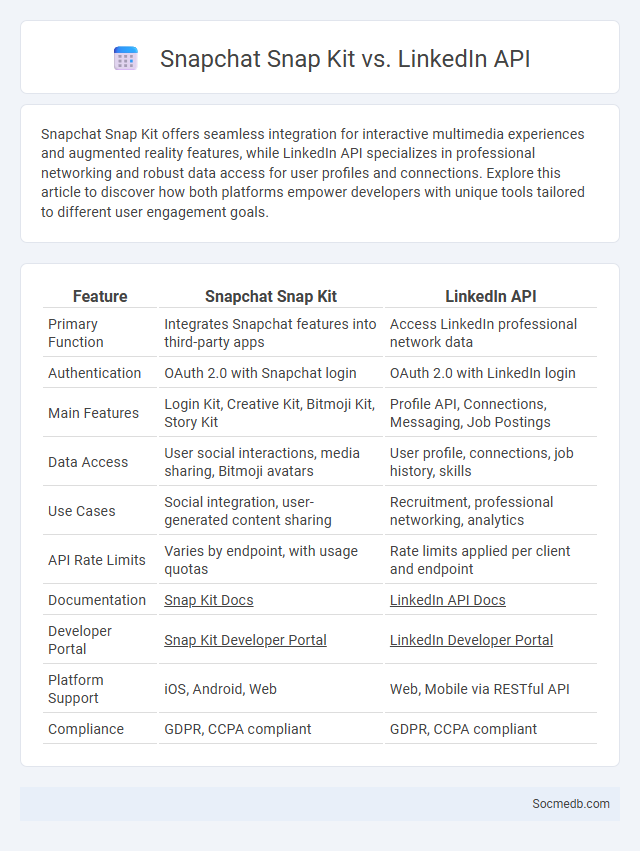
Photo illustration: Snapchat Snap Kit vs LinkedIn API
Snapchat Snap Kit offers seamless integration for interactive multimedia experiences and augmented reality features, while LinkedIn API specializes in professional networking and robust data access for user profiles and connections. Explore this article to discover how both platforms empower developers with unique tools tailored to different user engagement goals.
Table of Comparison
| Feature | Snapchat Snap Kit | LinkedIn API |
|---|---|---|
| Primary Function | Integrates Snapchat features into third-party apps | Access LinkedIn professional network data |
| Authentication | OAuth 2.0 with Snapchat login | OAuth 2.0 with LinkedIn login |
| Main Features | Login Kit, Creative Kit, Bitmoji Kit, Story Kit | Profile API, Connections, Messaging, Job Postings |
| Data Access | User social interactions, media sharing, Bitmoji avatars | User profile, connections, job history, skills |
| Use Cases | Social integration, user-generated content sharing | Recruitment, professional networking, analytics |
| API Rate Limits | Varies by endpoint, with usage quotas | Rate limits applied per client and endpoint |
| Documentation | Snap Kit Docs | LinkedIn API Docs |
| Developer Portal | Snap Kit Developer Portal | LinkedIn Developer Portal |
| Platform Support | iOS, Android, Web | Web, Mobile via RESTful API |
| Compliance | GDPR, CCPA compliant | GDPR, CCPA compliant |
Introduction to Social Media APIs
Social Media APIs enable developers to access, integrate, and manage data from platforms like Facebook, Twitter, and Instagram efficiently. These APIs facilitate automation, content sharing, and real-time analytics by providing structured endpoints for user interactions, posts, and media uploads. Understanding Social Media APIs empowers you to build customized applications that enhance user engagement and streamline digital marketing strategies.
Overview of Snapchat Snap Kit
Snapchat Snap Kit enables developers to integrate Snapchat's core features into their own apps, enhancing user engagement through seamless sharing and communication. It offers tools like Creative Kit for custom content sharing, Login Kit for easy Snapchat authentication, and Bitmoji Kit to personalize user avatars. By leveraging Snap Kit, your app can tap into Snapchat's vast user base, driving growth and social interaction efficiently.
Overview of LinkedIn API
The LinkedIn API provides developers with access to a vast professional network of over 900 million members, enabling integration of features such as profile retrieval, connections, messaging, and job postings into third-party applications. It supports RESTful endpoints for fetching detailed user data, company profiles, and analytics, facilitating enhanced recruitment, marketing, and networking capabilities. Robust authentication via OAuth 2.0 ensures secure and authorized access to sensitive professional information.
Key Features Comparison
Social media platforms vary widely in their key features, such as user engagement tools, content formats, and privacy settings. Instagram emphasizes visual content with Stories and Reels, while Twitter focuses on real-time news and concise updates through tweets. Choosing the right platform for your goals depends on features like audience reach, interaction types, and analytics capabilities tailored to your needs.
Authentication and User Privacy
Social media platforms implement multi-factor authentication (MFA) to enhance account security and prevent unauthorized access. User privacy is protected through data encryption, strict access controls, and compliance with regulations like GDPR and CCPA. Advanced AI algorithms continuously monitor suspicious activities to detect and mitigate potential privacy breaches.
Integration and Developer Tools
Social media platforms enhance user engagement through comprehensive integration and developer tools, including APIs, SDKs, and webhooks that streamline content sharing and real-time data synchronization across multiple applications. Advanced SDKs support seamless embedding of social features like login authentication, media uploads, and social analytics, enabling developers to build customized user experiences. Continuous updates to developer documentation and sandbox environments further facilitate rapid innovation and platform scalability.
Data Access and Permissions
Data access and permissions on social media platforms are critical for user privacy and security, governing how personal information is collected, shared, and utilized by third-party applications. Platforms implement strict permission settings that allow users to control access to their data, including location, contacts, and browsing history, which helps prevent unauthorized data exploitation. Compliance with regulations like GDPR and CCPA ensures social media companies maintain transparency and user consent regarding data access practices, enhancing trust and accountability.
Use Cases and Applications
Social media platforms enable businesses to enhance customer engagement through targeted advertising and real-time interaction, boosting brand loyalty and sales. Influencers leverage social media to monetize content by partnering with brands for sponsored posts and product promotion. Social media analytics provide valuable insights into consumer behavior, helping companies tailor marketing strategies and improve campaign effectiveness.
Pros and Cons of Each API
Social media APIs offer significant advantages such as seamless integration, real-time data access, and enhanced user engagement through features like content sharing and analytics. However, each API comes with limitations including rate limits, privacy restrictions, and potential security vulnerabilities that may affect your application's performance and compliance. Understanding the specific pros and cons of APIs from platforms like Facebook, Twitter, and Instagram helps you optimize your social media strategy effectively.
Choosing the Right API for Your Project
Selecting the right social media API depends on your project's goals, scalability needs, and target platforms. APIs such as Facebook Graph, Twitter API v2, and Instagram Basic Display offer diverse features including user data access, post management, and analytics, enabling robust integration. You must evaluate API documentation, rate limits, and data privacy policies to ensure seamless functionality and compliance with your project requirements.
 socmedb.com
socmedb.com